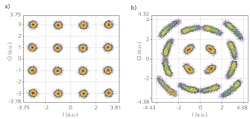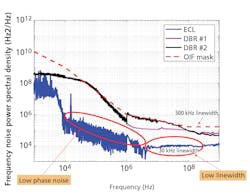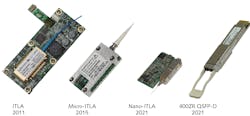Tunable external-cavity lasers power high-speed coherent transmission
Tunable lasers have been used in fiber-optic telecommunications since the advent of dense wavelength division multiplexing (DWDM) systems in the late 1990s. Initially, the need for tunability was driven by the need to simplify the logistics of different laser part numbers for each of up to 96 different DWDM channels. Since the advent of coherent transmission technology a decade ago and the more recent arrival of small-form-factor pluggable 400 G coherent modules, ever more stringent performance requirements have been imposed on the tunable laser, including ultranarrow linewidth, very low phase noise, low electrical power consumption, small size, and broader tuning ranges.
Tunable lasers based on an indium phosphide gain chip and an external laser cavity using micro-optics or silicon photonics satisfy a broad set of these requirements and have emerged as the leading technology to power the highest speed deployments of coherent systems.
Coherent transmission
Coherent transmission differs from legacy “direct detect” techniques in that information is encoded in the phase as well as the amplitude of the optical signal—the phase information is recovered by comparing the signal to a local oscillator laser followed by digital signal processing, similar to the heterodyne detection techniques that have been used in radio and microwave transmission for decades.
Coherent transmission has many advantages over direct detect methods, including greatly improved signal-to-noise (i.e., higher noise tolerance), the ability to pack more than one bit per symbol (i.e., on-off keying), transmission on both polarizations, increased range due to digital compensation of fiber impairments, and more flexible reconfiguration. These advantages have led to coherent transmission becoming dominant for high-speed data transport for reaches of 80 km all the way up to subsea cable systems. Leading commercial systems now transmit 800 Gbit/s on a single wavelength with up to 32 or more wavelength channels on a single fiber.
The technology advances that enable coherent techniques at optical frequencies include advanced digital signal processor (DSP) ASICS, photonic integration of coherent modulators and receivers, and ultranarrow linewidth tunable lasers. In direct detection systems, only the intensity of the light is measured. A bit is determined to be either a 1 or a 0 by the presence or absence of photons and does not depend on their phase. Linewidth describes how stable the phase of a laser is. Since direct detect systems do not use the phase of the signal, linewidth for these systems is not a critical parameter and typically linewidths of 10 MHz or more were used.
Coherent transmission, however, does encode information in the phase of the optical signal and therefore phase noise is relevant, and wider linewidths can result in degradation of the signal.
Shown in Figure 1 is the constellation for a 16 quadrature amplitude modulation (QAM) coherent signal received without (a) and with (b) phase noise. In Figure 1b, the laser phase noise induces phase rotations for the constellation points along the three constant radii in the 16 QAM constellation. The negative effect is that some of the neighbor constellation points cannot be clearly distinguished, which results in a higher system bit-error rate.
Lower laser phase noise is required for systems operating with a high-order modulation, as denser arrays of constellation points will be more sensitive to distortions. In addition, systems operating with high baud rates and/or long transmission distances are susceptible to equalizer-enhanced phase noise, described below. This imposes stringent requirements on the local oscillator (LO; the laser used in a coherent receiver as a reference to which the signal is compared) phase noise. Therefore, only lasers with a “pure” frequency (narrow linewidth and low phase noise) can be used in the highest-performance coherent systems.
External cavity lasers
The laser types that have been used for coherent transmission include distributed feedback (DFB) arrays, distributed Bragg reflector (DBR) lasers, and external-cavity lasers (ECLs). The first two technologies integrate the reflectors into the same semiconductor chip that contains the gain medium, which limits the total cavity length and therefore the linewidth. ECLs use an optical cavity separate from the semiconductor gain chip. The cavity can be formed by micro-optic elements or by a silicon photonics integrated chip using microring resonators (MRRs; see Fig. 2). This allows the cavity to be extended without encountering excess loss in the semiconductor waveguides. Basic laser cavity theory shows that the longer the cavity, the narrower the linewidth of the laser. However, the performance of the laser in a coherent system is more complicated than can be expressed by a single linewidth number.Laser linewidth and phase noise
To understand how linewidth and phase noise affect coherent transmission, we must understand how the phase noise is distributed in the frequencies adjacent to the fundamental laser frequency. Laser phase noise power spectral density (PSD) Sp(f) is a term used to quantify the laser phase noise power distribution as a function of frequency. An important point is that a changing phase results in a changing frequency. Thus, the underlying noise can be equivalently described by laser frequency noise PSD SF(f). It is more common that tunable-laser manufacturers measure SF(f) to ensure the laser frequency pureness, with the understanding that SF(f) and Sp(f) are related by SF(f) = f2 × Sp(f).
An example of the laser frequency noise PSD (SF(f)) measured from an unmodulated pluggable coherent transceiver is shown in Figure 3. Three main frequency components are shown in Figure 3: 1) The white noise region above ~10 MHz; 2) the non-flat 1/f noise (“flicker noise”) region between 200 KHz and 10 MHz; and 3) the multiple interference tones spread across the frequency range below 10 MHz. The white frequency noise PSD originates from spontaneous emission noise and is directly related to the conventional laser linewidth, as shown in Figure 3. In other words, a narrower laser linewidth corresponds to a lower white frequency noise level.The origin of 1/f frequency noise is not clear but is particularly high in a DBR tunable laser, especially when its phase section is used to tune wavelengths. Even when thermal tuning is used to replace the phase tuning, a DBR tunable laser still presents much higher 1/f noise than an ECL. The multiple interfering tones are caused by switching power supplies and various circuits in a pluggable coherent module.
The most important impact of laser frequency or phase noise on a coherent transmission system resides in a phenomenon called equalizer enhanced phase noise (EEPN). This happens when transmitted pulse width is significantly broadened by the accumulated chromatic dispersion (CD) over a transmission distance of optical fiber. In the meantime, if the local oscillator (LO) phase noise fluctuates significantly over this broadened pulse period, the beat product between the received pulse and the LO would experience significant amplitude noise through phase-to-amplitude conversion at a receiver digital CD equalizer. As a result, the combination of all three types of frequency noise in a local oscillator laser can greatly affect the system performance.
Many recent experiments have proven that narrow laser linewidth and low 1/f laser frequency noise are essential to 600 Gbit/s, 800 Gbit/s, 1 Tbit/s, and 1.2 Tbit/s per wavelength coherent systems. For example, for 800 G, the OSNR penalty is almost 2 dB for transmission more than 400 km, and for 600 G, the penalty is more than 2 dB at 400 km. This is significant because a 2 dB OSNR penalty corresponds to a 40% distance reduction. As the baud rate and modulation order are both growing in the foreseeable future, the requirement of laser linewidth and 1/f laser frequency noise level can only become more and more stringent.
Size, form factor, and power consumption
While size and power consumption are always important attributes for any laser or other component, recent advances in both optical components and DSPs have made it possible to put the equivalent of a coherent line card in a small-form-factor pluggable transceiver. Line-cards and other embedded systems have higher tolerance for higher power and larger size, but new small-form-factor pluggables, such as DD-QSFP and OSFP, have a very tight physical space—and even more critically, they have very limited ability to dissipate heat.
Fortunately, advances in tunable laser packaging have kept pace with these requirements. In 2011, most tunable lasers shipped in the then-standard optical internetworking forum (OIF) ITLA form factor, which is pictured on the left in Figure 4. This was approximately 74 mm long and 30.5 mm wide. By 2015, most tunable lasers shipped in the updated OIF Micro-ITLA form factor, which cut the footprint almost in half.Now, in 2021, a new-generation form-factor Nano-ITLA cuts it almost in half again. The Nano-ITLA is designed to fit inside a pluggable 400 ZR QSFP-DD, or OSFP module (see Fig. 4, right). The QSFP-DD or OSFP is a full coherent transceiver capable of transmitting 400 Gbit/s data over a 120 km distance (and further in the 400 ZR+ version) in a standard client-side form factor with dimensions of approximately 78 mm long by 20 mm wide. This is smaller than just the laser itself was in 2011, and this reduction in size was accomplished without impacting the laser linewidth and phase noise performance.
Equally important for small-form-factor coherent pluggable modules is the electrical power consumption of the laser. Electrical power consumption is very often the limiting factor in the performance of such modules. The DSP is the largest consumer of power in the module, and most performance transmission improvements require the DSP to work harder and therefore consume more electrical power and generate more heat. To provide this power, all other components must use as little power as possible, with the laser being the second biggest power consumer in the module. However, reducing the electrical power consumption cannot come at the expense of reducing the optical output power. High laser output power is required to compensate for insertion loss in silicon photonics components and for the modulation loss that results when using higher-order modulations. ECLs are efficient at converting electrical power to optical power due to the lower loss of the cavity optics. Also, they are generally the lowest in power consumption among different types of tunable lasers.
Spectral tuning range
The total data capacity of a fiber is determined not just by the data rate of a single channel, but also by how many DWDM channels can be transmitted. The number of channels has traditionally been limited by the spectral window of erbium-doped fiber amplifiers (EDFAs), which defines the C-band extending from 1528 nm to 1565.5 nm, encompassing approximately 4.8 THz of spectrum. For legacy direct-detect systems operating at 10 Mbit/s on a 50 GHz DWDM grid, this gives 96 channels and the total fiber capacity of 960 Gbit/s.
But now, lasers, modulators, receivers, and EDFA amplifiers have been developed that extend the C-band both higher and lower in wavelength to form the C++—also called the super C-band—which extends from 1524 nm to 1572 nm with an available optical spectrum of 6 THz. ECLs can operate over this extended range with little degradation in performance due to the good performance of the external cavity over the extended range.
Using 400 ZR QSFP-DD pluggable modules operating on a 75 GHz DWDM grid, the C++ band supports 80 channels and a total fiber capacity of 32 Tbit/s. The traditional C-band capacity can be doubled again by also using the L-band, which extends from 1565.5 nm to 1611.8 nm, encompassing 5.8 THz of spectrum. However, this would require using a second amplifier train in the optical transport system.
ECLs achieve the purest optical signal as measured by narrow linewidth and low phase noise, which makes them the laser of choice for the highest speed coherent links. This advantage grows as speeds move to 600 Gbit/s, 800 Gbit/s, and in the near future, 1.6 Tbit/s over distances. In addition, ECLs have a broad array of beneficial features, including high optical power coupled with low electrical power consumption, small size, and broad tuning range.
Mike Desmond | Vice President and Product Line Manager for Coherent Components, NeoPhotonics
Mike Desmond is Vice President and Product Line Manager for Coherent Components at NeoPhotonics. He has served in multiple positions at NeoPhotonics since joining the company in 2004. Previously, he held senior sales positions at Finisar and Raychem. Desmond graduated from Rensselaer Polytechnic Institute and served as an officer in the U.S. Navy from 1991 to 1997.



